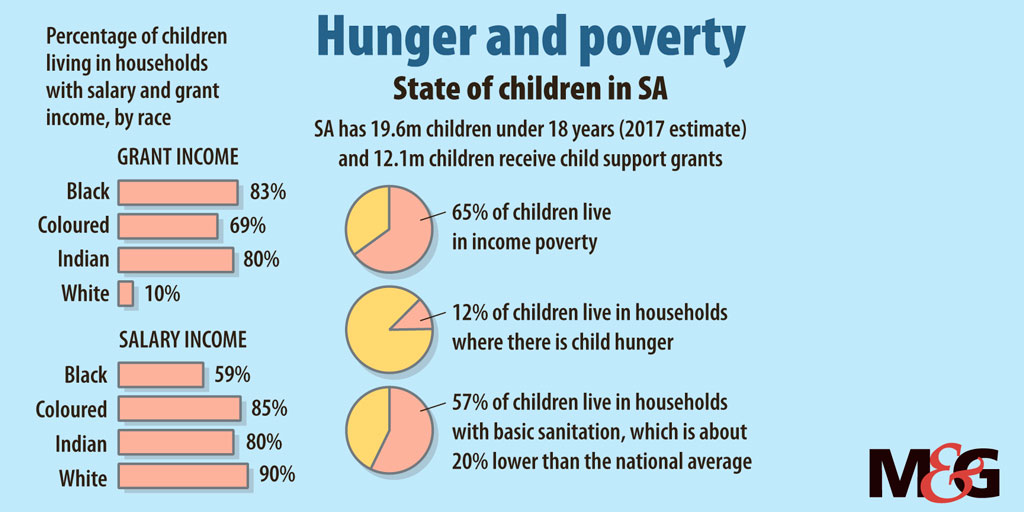With more than 19-million children in South Africa, the majority are on child grants and more than 60% of them live in income poverty. (Madelene Cronje/M&G)
More than 2.2-million black children live in households that reported child hunger. This amounts to 13% of the total black child population.
Nineteen percent of children in the poorest homes go hungry sometimes, compared with fewer than 1% in the wealthiest.
This is according to the annual Child Gauge, an ongoing data and advocacy project of the Children’s Institute at the University of Cape Town. Its 2018 report was released this week and shows that, although some gains have been made in education and in reducing child poverty and child mortality rates, very little has changed regarding child hunger since 2006.
The provinces with the largest numbers of children and high rates of child hunger are the Northern Cape, KwaZulu-Natal, North West and the Western Cape. Children in KwaZulu-Natal are the most likely to report that they have gone hungry.
“The government has introduced a number of programmes to alleviate income poverty and to reduce hunger, malnutrition and food insecurity, yet 2.3-million children live in households where child hunger was reported in 2017. There was a significant drop in reported child hunger, from 30% of children in 2002 to 16% in 2006. Since then the rate has remained fairly consistent,” the report reads.
“Together these provinces have over 1.4-million children living in households that report having insufficient food for children. Hunger, like income poverty and household unemployment, is most likely to be found among African children.”
Poor black children are also most likely to grow up in households without either parent.
Out of 48 countries, including Ghana, Tanzania and Nigeria, South Africa has the highest number of children who live without both their parents. Of these, the most are poor black children in the Eastern Cape.
The report states that, in the Western Cape and Gauteng, about half the children live with both parents, which is higher than the national average.
“In contrast, close to a third of children (33%) in the Eastern Cape live with neither parent. These patterns are consistent from 2002 to 2017,” reads the report.
Limpopo has the highest percentage of children who do not live with their fathers but with their mothers. Only 2% of fathers are present.

“Less than one-third of African children live with both their parents, while the vast majority of Indian and white children, 83% and 78%, respectively, reside with both biological parents. These figures are striking for the way in which they suggest the limited presence of biological fathers in the home lives of large numbers of African children,” the report reads.
Lori Lake, from the Children’s Institute, said families and households are fluid and change over time as families seek to balance the need for employment against their need to provide care, education and a safe environment for their children.
“It is difficult, if not impossible, to earn an income and care for children at the same time. Few fathers pay regular maintenance and state support in the form of the child support grant remains small, only R410 a month. Therefore, many women migrate in search of employment and rely on extended family to care for their children.
“It is therefore not surprising that child poverty is greatest in extended family and lone parent households, where 85% and 81% of children are poor,” she said.
Lake added that women continue to carry the primary burden of childcare, and this is often physically and emotionally demanding.
With more than 19-million children in South Africa, the majority are on child grants and more than 60% of them live in income poverty.
Though there has been a general decline in the number of children living in poverty in all provinces, Limpopo, again, has the highest percentage at 81.2%. The majority of children in the province are beneficiaries of social grants and living in income poverty.